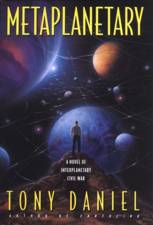


Metaplanetary
Published by Avon/Eos
Mass Market Paperback, 464 pages
HB Published date: April 2001
Retail Price: $7.99
First, a warning....
This is half a book. Although it is almost 500 pages, it ends just as the "interplanetary civil war" is about to begin. The sequel, to be called (I understand) Superluminal should be out shortly. It is the history of the war between the inner system -- the Met, which can extend no further than the asteroid belt, and the outer system, home of the Cloud Ships, great nebular AIs the size of moons that live in the Oort Cloud.
Here is a blurb from the inside jacket cover:
Once or twice in a score of years, the boundlessly inventive realm of speculative fiction reveals a vision of tomorrow that dwarfs everything that came before. These are the dreams of the Asimovs and the Heinleins, the Bears and the Brins. Now Tony Daniel brilliantly dreams the future -- and reinvents humanity itself -- in an epic chronicle of civil war and transcendence that plays out on an enormous stage encompassing the solar system in its entirety -- its asteroids, its comets, and all its people, transmuted into astounding forms and living astonishing lives.
Metaplanetary
The human race has extended itself into the for reaches of our solar system -- and, in doing so, has developed into something remarkable and diverse and perhaps transcendent. The inner system of the Met -- with its worlds connected by a vast living network of cables -- is supported by the repression and enslavement of humanity's progeny, nanotechnological artificial intelligences -- beings whom the tyrant Amés has declared non-human.
Okay, fine. Enough of that.
An exerpt from Richard Horton, who in his fine review at Amazon said:
For the most part, the solar system is in something of a Golden Age. The physical needs of people seem to be well supplied. A critical political issue is the rights of "free converts". Some do not consider them "Human" -- they are just computer programs, in this view, without real free will, without, if you will, "souls". But others, especially in the outer system, regard them as clearly human.
The novel is told from a variety of points of view: a couple of cloudships; a free convert named Danis Graytor; Danis' human husband Kelly; their daughter Aubry (who has a human body but is considered a "half free convert"); an artificial woman named Jill with a body made of grist and a brain based on a ferret's; Colonel Roger Sherman, the military leader of Triton's forces; Sherman's son Lee; Director Amés, the leader of the Met government; General San Filieu, an aging Catalan woman (and LAP) under Amés influence who leads the Met attack on Triton; and more. This gives us a good look at the variety of ways people live in this future, and at what it is like to be a free convert, or a cloudship, or a human with a pellicle and convert attachment, or a LAP. This also helps keep the action moving, important in a fairly long book.
The book has chunks of rough language which I found unnecessary, but you know me, Al... One of the critical things in this book, however is the love and sex possible between all sorts of humans and AIs. The primary point of this book is "What does it mean to be human?" And I could believe the scenes of torture of an AI. The reader cares for the "free convert" and hates the so-called human who sees nothing human in the AI whose interior life we KNOW.
As I read along, little bits of business, throwaway stuff almost, told me I was in good hands. And I recommend this book. It made me think, and it definitely made me want to read book 2.
Copyright © 2003 by Jerry Wright